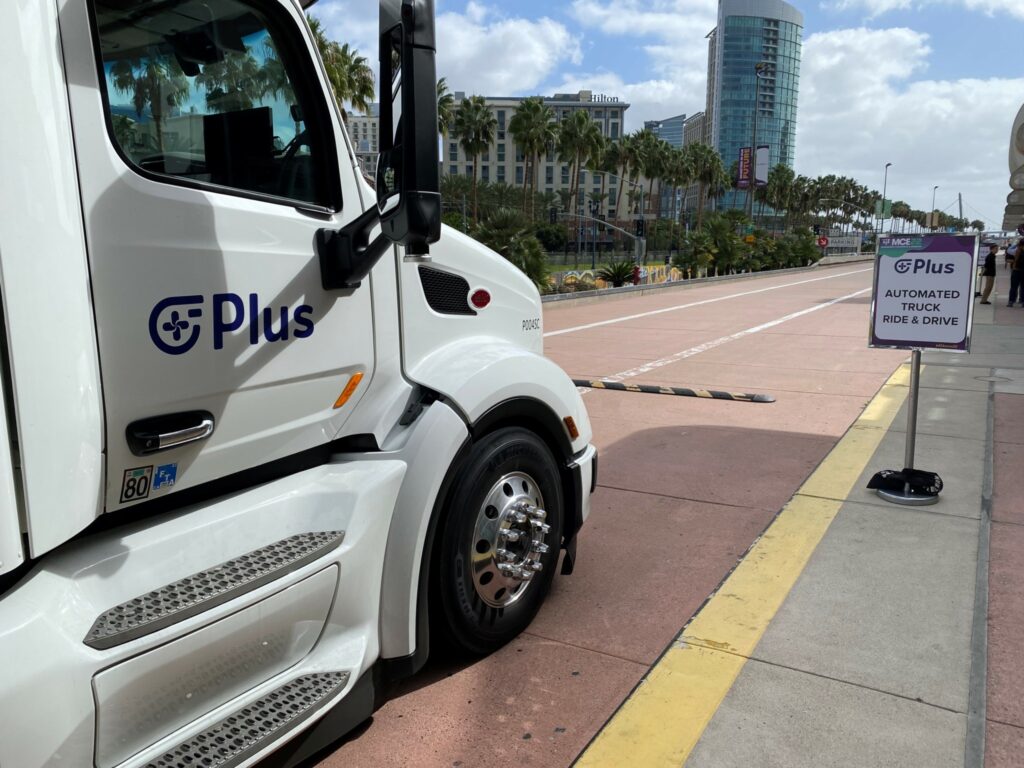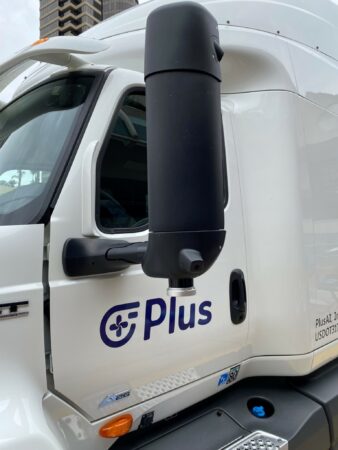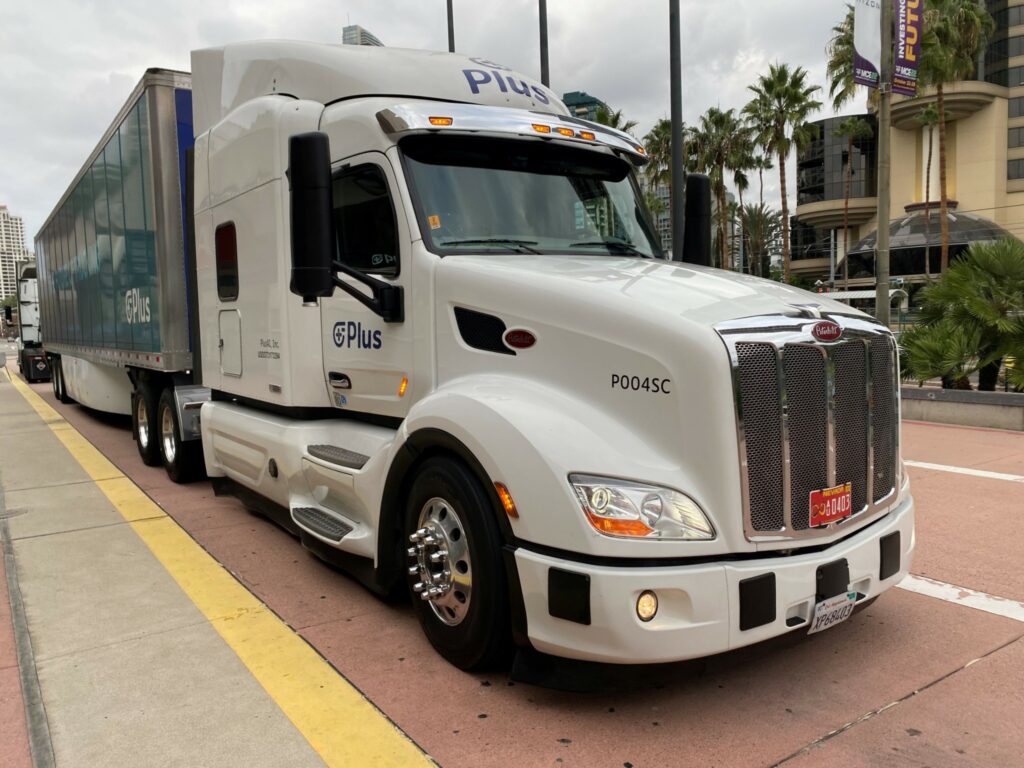Behind the wheel of a Pete 579 with PlusDrive autonomous truck tech
It was the first time I’ve had my driver’s abstract pulled prior to a test drive, and this for a truck that would do most of the driving itself. But if the lawyers at Plus were nervous about the company allowing on-road test drives, those who designed its autonomous trucking system were anything but.
The Plus team was clearly proud to be the only business in the increasingly crowded autonomous commercial vehicle space to allow someone without an engineering degree or an Employee Number to experience the system from the driver’s seat. Test drives were offered on I-5 near the San Diego Convention Center where the American Trucking Associations held its Management Conference & Exhibition in late October. And Plus was rewarded with a full roster of intrigued fleet executives who signed up for the opportunity to get behind the wheel.
The SAE Level 2 autonomous PlusDrive system can currently be retrofit on International and Paccar Class 8 trucks and is the only such system available for purchase today. Velociti handles the installations, and has a presence in Canada where it partners with an unnamed third party to do the actual work. For now, however, Plus itself doesn’t have any trucks deployed north of the 49th parallel even though there’s nothing preventing its system from working here.
Some autonomous trucking systems require routes to be pre-loaded before the truck can be turned loose. PlusDrive, however, can function anywhere – its combination of radar and cameras reading lane markings and road signage as it travels, even along a route it hasn’t seen before.

How it works
PlusDrive fuses LiDAR, camera, and radar, sending collected information to an electronic control unit (ECU) that’s unobtrusively mounted between the seats. Specifically, the system comprises forward-facing cameras and radar, rear-facing cameras, radar and LiDAR, side-facing cameras, radar, and LiDAR, the ECU, and a human machine interface (HMI) in-cab display. That’s two LiDAR sensors, three radars, and eight cameras if you’re keeping score.
It takes about a day to retrofit an existing truck with all the hardware. PlusDrive’s decision-making is based on feedback from actual drivers and the driver will always be in control, even when automation is activated.
PlusDrive has torque sensors on the steering wheel and a driver-facing camera to ensure the human driver is constantly engaged with both hands on the wheels and eyes on the road. If it detects that the hands have been removed from the steering wheel or eyes from the road for more than 15 seconds, an alert is sounded. After 30 seconds, if a response hasn’t been received, the truck will begin to automatically slow, eventually coming to a controlled stop in its lane. This means if a driver is incapacitated, the truck will safely bring itself to a stop.

When driving, I could feel the steering wheel oscillating within my loose grasp, however, the brake and throttle pedals don’t physically move when speed or braking is applied. Finding the right pressure points on the steering wheel took some getting used to in order to avoid the audible hands-on alerts.
PlusDrive also has lane-centering capabilities, and will nudge the truck in one direction or another when necessary, for example when passing a wide load that infringes on the Plus truck’s lane. The adaptive cruise control (ACC) feature maintains a safe following distance and will slow as required to prevent tailgating.
The human driver can always override the system and there are times he or she must do so. Lane changes, for example, are only done with the approval of the driver even though the system itself can suggest and execute them.
To initiate a lane change, the driver quickly turns the signal light on-off-on in the direction of the desired lane change. From there, the system will execute the lane change if and when it’s safe to do so. When prompted to make a lane change, only a single activation of the signal light is required.
“The system is very conservative. It won’t cut off traffic in a heavy traffic scenario. It will wait until it’s safe and clear and we have enough room to perform the lane change,” Alberto Navarro, vehicle operations specialist at Plus told me.
Any time the PlusDrive system makes a decision, it will go with the safest option available. A human driver, on the other hand, may have a greater appetite for risk. PlusDrive is also immune to human cues. It will disregard a flick of the headlights that signals permission to pull in front of another truck, for example. It also won’t get its feelings hurt if another motorist flips it the off because it feels it’s driving too cautiously. I didn’t find this to be the case on my drive, as the PlusDrive system was more courteous with merging traffic than I may have been on my own.
PlusDrive’s Level 2 autonomous driving system is intended to complement drivers, not replace them. And it aims to deliver a payback based on improved safety, fuel economy enhancements (up to 10% compared to a human driver, the company claims), and by improving the driving experience, improving driver retention. Traffic jam assist is a feature that falls into the latter category. When conditions dictate, the truck will stop and go with the pace of traffic on its own, allowing the driver to rest their leg.
PlusDrive will never speed, but the driver is always able to override the system if more speed is required, for instance when passing another vehicle. It uses GPS to determine legal road speeds, so there may be times (ie. in construction zones) where it’s incumbent on the driver to take over and slow the truck.
The in-cab HMI display shows what the system is doing and when it’s available for use. PlusDrive won’t function on surface streets, only freeways. It also won’t automatically enter weigh stations or respond to emergency vehicles. More reasons for the driver to stay alert.
The predictive fuel optimization feature accounts for road gradients and curves to maximize coasting time and maintain the speed limit. The corresponding fuel savings are where fleets using PlusDrive are seeing benefits today.

On the road
Once I navigated the truck and loaded 53-foot trailer onto I-5, I was notified via the HMI display that PlusDrive was ready to go to work. The system is activated using buttons on the existing smartwheel. Two quick depressions of the “+” or Set cruise buttons activate PlusDrive. It can be deactivated with a single press of the “–” or Resume cruise buttons, or by pressing the brake or throttle pedals.
The speed setting can also be adjusted in 1 mph intervals using the steering wheel controls. Given my short time with the truck on the highway, I wanted to experience as much of its capabilities as possible and stayed in the far right lane where there was frequent engagement with traffic merging on and off the freeway. It’s a smart system and fit in nicely with the busy flow of traffic.
Of course, there are limitations to PlusDrive’s abilities. If lane markings aren’t visible, it will prompt the human driver to take over. This could be due to road resurfacing or snow. While the system has been tested in adverse weather conditions, including snow, I was told it’s best to take over when snow interferes with lane marking visibility. Light to moderate rain is just fine.
PlusDrive also won’t always avoid road debris, such as large potholes. The human driver can dodge these while keeping the system activated by simply maneuvering the truck within its lane. PlusDrive will identify pedestrians, but when it comes to wildlife the driver’s on their own to determine the best course of action.
PlusDrive is a comforting co-pilot that can offer a trusted second opinion when needed, always erring on the side of caution, and can automate certain monotonous tasks such as driving in stop-and-go traffic. It’s not a driver replacement system – at least not at this point. And it’s limited to highway driving, so the truck won’t be practical for regional hauls.
But in the right applications it can provide a fleet with greater safety, fuel economy improvements, and the ability to attract and retain the tech-savvy driver. It’s the only such system commercially available for retrofit today and a great introduction to autonomous trucking, its benefits, and limitations.
Have your say
This is a moderated forum. Comments will no longer be published unless they are accompanied by a first and last name and a verifiable email address. (Today's Trucking will not publish or share the email address.) Profane language and content deemed to be libelous, racist, or threatening in nature will not be published under any circumstances.
I think it is useless feature. We need more right people in this industry. First off get manual transmission trucks back and you will see less accidents. The accidents have risen because anyone can drive a truck and with that you get bad people in this industry as well. Skilled people are required not just anyone with a CDL.